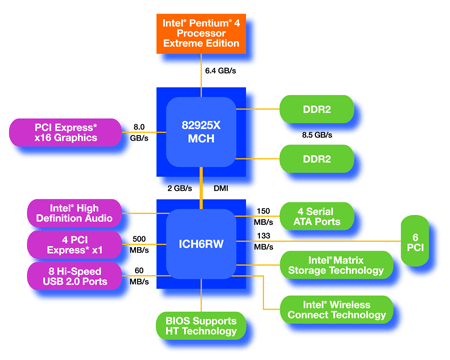Intel i925X and i915G Architecture, Pentium 4 560 and 3.4GHz EE - The LGA775 Debut
i925X and Common Chipset Architecture

As we noted earlier, most of the functional blocks for Intel's i915 and i925X chipsets, are common throughout both product families. The i925X or "Alderwood" chipset is a up-scale "enthusiast" class version, that Intel likes to pair with the Pentium 4 Extreme Edition. However, with the exception of its DDR2 and discrete graphics only implementation, it isn't that much different than the i915, in terms of its over all feature set.
|
The i925X does have better data optimization, ordering and queuing characteristics, versus the i915. The Northbridge, which supports only new DDR2 memory, has the ability to allow maintenance instructions to be inserted into and re-ordered within the data path. Again, more efficient use of available system memory bandwidth is the net result.

PCI Express Goes Forth -
The advent of the PCI Express, for graphics and data, marks an important milestone in the evolution of the PC. Although modern processor cores have gotten faster and more efficient over the years, the speeds, feeds and data lanes going to and from them, haven't scaled nearly as robustly. As such, getting on and off chip, whether it be a CPU or GPU, has become a significant gating item.
PCI Express is a serial point to point communications link between two devices, unlike PCI's traditional "shared" bus architecture. PCI Express delivers 500MB/sec of available bandwidth (250MB up and downstream across 2 sets of differential paired wires) on a 1X lane, versus 133MB for standard PCI, which again can be shared by a number of devices. For graphics, the X16 or 16 lane implementations offer 8GB/sec (4GB bi-directional) versus 2.1GB/sec for AGP8X. Short and sweet, bandwidth is your key to the highway here, and PCI Express is a big leap forward. Also again, remember these are dedicated point to point connections, not bus structures, so there is no arbitration as is required for standard PCI. As a result, PCI Express also allows for significantly more efficient use of its bandwidth.
Intel High Def Audio -
The days of AC97 codecs are over folks, make room for High Definition Audio CODECs. We're talking 192kHz, 24 bit, 8 channel audio from an on-board solution. This feature could make the folks at Creative Labs and the like, a bit nervous. Another nice feature that Intel is bringing to the table here is "jack re-tasking". Unfortunately we didn't get a chance to demonstrate this but the concept is that you can re-assign the functionality of a given audio jack on your motherboard, based on the functionality of a device that is plugged into it. Need to move that mic around to another port? The idea is you no longer have to get up and crawl behind your PC. You can just re-map it to another jack. We'll cover the performance of Intel's new High Def Audio solution, later in this article.
Intel Matrix Storage Technology -
It should be fairly obvious by now that Intel clearly has their sites set on the PC enthusiast, as is evident by their inclusion of full SATA RAID functionality, in both their high end and mainstream chipsets. Intel's new ICH6 Southbridge chip now supports "Native Command Queuing" or "NCQ" technology. Native command queuing, which is part of the Serial ATA II specification, allows up to 32 instructions to be queued and reordered by the SATA controller, in this case Intel's ICH6. Again, this is another method of managing data for peak bandwidth efficiency.
In addition, Intel's new Southbridge brings the ability to setup both RAID 0 and RAID 1 arrays on only two drives. So now users have the ability to partition part of their drive array for redundancy and data integrity, and simultaneously run another partition for RAID 0 performance. This is the first time this innovation has been brought to any integrated Southbridge controller and it's going to be a great feature many users will make use of.
Intel Wireless Connect Technology -
Intel's vision of the Wireless Home and Enterprise infrastructure has been vigorously evangelized for quite some time now, since the launch of their Centrino mobile processor. With the introduction of their new ICH6 Southbridge for the PC, they have extended that vision to the desktop. The new ICH6 has built-in Wireless Access Point and Switch functionality, that coupled with an 802.11b/g MAC and Radio, lets your PC connect to an existing Wireless LAN or act as a Wireless Access Point or Hub. Here you get full WEP encryption support, NAT (network address translation) and DCHP server features. Although neither of the Intel motherboards we received had a wireless NIC on them, we did receive an Asus board (to late for this article, unfortunately) that has this capability fully configured with software. We'll be sure to report back to you on this functionality in a future article.








